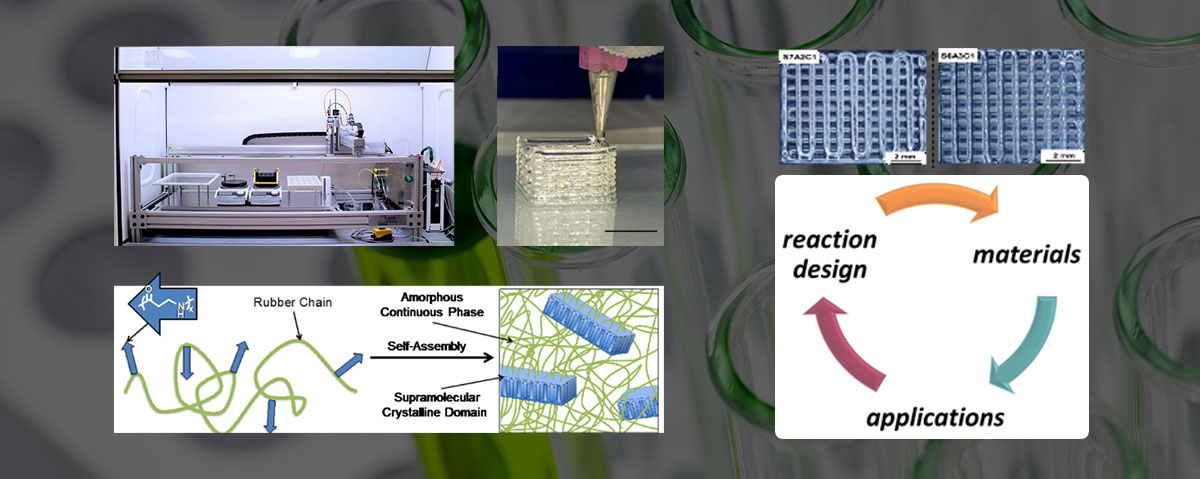
Polymer Chemistry Research
OVERVIEW
Mission Statement: The design of new polymers has greatly benefited society and transformed all facets of modern life. The Univ. of Akron has been at the forefront of research in developing methods and techniques for novel Polymer Chemistry. Research in the School of Polymer Science and Polymer Engineering (SPSPE) continues to push the boundaries of polymer chemistry, including synthesis and characterization, as we move forward towards the challenges of this decade.
Technical Focus: SPSPE faculty expertise cover all aspects of modern polymer synthesis, including rubber chemistry, transition metal-catalyzed polymerizations, ionic polymerizations, controlled radical polymerizations, emulsion polymerization, ring-opening polymerizations and step-growth polymerizations.
Why Akron: Akron, OH is at the center of the tire and plastics industry and many of these companies look to UA for insights into the synthesis of their products as well as for discovering new polymers and applications. Students in SPSPE participate in collaborative cutting-edge research that prepares them for careers in industry and academia. Industrial collaborators get to take advantage of our complete set of expertise in Polymer Chemistry, Polymer Engineering and Processing.
POLYMER CHEMISTRY FACULTY
RESEARCH HIGHLIGHTS
Representative Publications
- Zhang, X.; Zhao, J.; Ye, C.; Lai, T.-Y.; Synder, C.R.; Karim, A.; Cavicchi, K.A.; Simmons, D.A. Dynamical Correlations for Statistical Copolymers from High-Throughput Broad-Band Dielectric Spectroscopy ACS Combinatorial Science 2019, 21, 276-299. DOI: 10.1021/acscombsci.8b00160
- Deng, G.; Cavicchi, K.A. Tuning the Viscoelastic Properties of Poly(n-butyl acrylate) Ionomers Networks through the Use of Ion-Pair Comonomers. Macromolecules2017, 50, 9473–9481. DOI: 10.1021/acs.macromol.7b01529
- Hsu, T-G.; Zhou, J.; Su, H-W.; Schrage, B. R.; Ziegler, C. J.; Wang, J. “A Polymer with “Locked” Degradability: Superior Backbone Stability and Accessible Degradability Enabled by Mechanophore Installation”, J. Am. Chem. Soc., 2020, 142, 2100-2104.
- Dai, Y.; He, S.; Peng, B.; Crandall, L. A.; Schrage, B. R.; Ziegler, C. J.; Jia, L.* “Zwitterionic Design Principle of Ni(II) Catalysts for Carbonylative Polymerization of Cyclic Ethers”, Angew. Chem., Int. Ed. 2018, 130, 14111-14115
- He, T., Xie, A., Reneker, D. H., Zhu, Y.; A Tough and High-Performance Transparent Electrode from a Scalable and Transfer-Free Method. ACS Nano 2014, 8 (5), 4782–4789
- Zhang, H., Deng, R., Wang, J., Li, X., Chen, Y-M., Liu, K., Taubert, C. J., Cheng, S. Z. D., Zhu, Y.; Crystalline Organic Pigment-Based Field-Effect Transistors. ACS Appl. Mater. Interfaces 2017, 9, 21891−21899.
- Narayanan, A., Menefee, J.R., Liu, Q., Dhinojwala, A., Joy, A.; Lower critical solution temperature-driven self-coacervation of non-ionic polyester underwater adhesives; ACS Nano, 2020, 14, 8359
- Liu, Q., Jain, T., Peng, C., Peng, F., Narayanan, A., Joy, A.; Introduction of hydrogen bonds improves the shape fidelity of viscoelastic 3D printed scaffolds while maintaining their low-temperature printability; Macromolecules, 2020, 53, 3690
